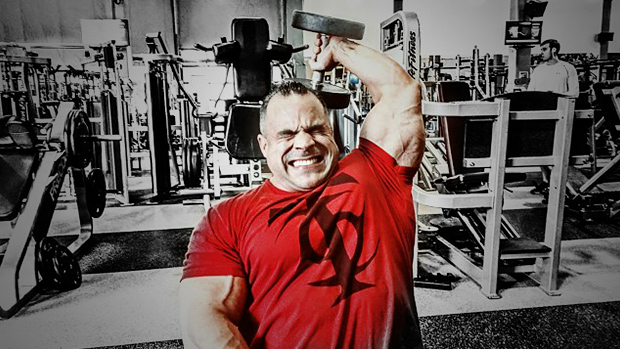Little Pink Dumbbells Won't Cut It
Some people don't go close to failure on any of their sets. They've heard that volume is the key driver of hypertrophy (muscle growth). Consequently, they focus on accumulating as much volume as possible: more sets, more total reps, more exercises, etc.
They choose to do a ton of work, but none of it's very challenging. They never get close to failure, but this violates the principle of overload. For training to be effective it needs to disrupt homeostasis enough to cause adaptation.
Pulling and pushing thousands of reps with the pink dumbbells might help to achieve incredible training volumes, but it won't overload the body and cause growth. They're not "effective reps."
You need to recruit and fatigue most of the motor units and muscle fibers in a muscle to stimulate maximum muscle growth. Effective reps are the reps that do this. They're the ones you gut out as you approach failure. That's why Arnold famously said, "The last three or four reps are what makes the muscle grow."
Techniques such as rest-pause, drop sets, super sets, and tri-sets all offer the potential for you to do more effective reps, but there's much more to the science of effective reps than these common training methods.
I first heard the term effective reps when reading about Borge Fagerli's Myo-rep training protocol where you're required to do an "initial" or "activation" set. This causes full, or close to full, fiber recruitment.
After this initial set, you perform multiple mini-sets with a series of short rests between. All of the reps done in these mini-sets are close to failure and maintain a state of high muscle activation, so you elicit an effective training stimulus from every single rep.
To illustrate this point, Fagerli provided the following example comparing a traditional 3 sets of 20-reps protocol with a Myo-rep set (the asterisks denote the "effective" reps):
- First Set (activation set): 1 2 3 4 5 6 7 8 9 10 11 12 13 14 15* 16* 17* 18* 19* 20*
- 1-2 min of rest
- Second Set: 1 2 3 4 5 6 7 8 9 10 11 12 13 14* 15* 16* 17* 18*
- 1-2 min of rest
- Third Set: 1 2 3 4 5 6 7 8 9 10 11 12* 13* 14* 15* 16*
In the example, we started off with a set of 20, with the last 6 reps being the most difficult, i.e., the effective reps. We experienced some fatigue in the second set, only being able to pump out 18 reps, but nevertheless, the last 5 reps were the effective ones.
We experienced a little more fatigue in the third set, only doing 16 reps, but again the last 5 were the effective reps.
We ended up doing 54 total reps in about 6 minutes, where 16 reps were "effective" reps (recruited a large amount of fibers).
Let's compare the above with a Myo-rep set, where instead of taking 1 to 2 minutes of rest between sets, we only rest for 15 seconds. Because of the huge amount of fatigue and short rest periods, we end up doing a lot more effective reps. Once again, the asterisks denote the effective reps:
- 1 2 3 4 5 6 7 8 9 10 11 12 13 14 15* 16* 17* 18* 19* 20*
- 15 seconds rest
- 1* 2* 3* 4* 5*
- 15 seconds rest
- 1* 2* 3* 4* 5*
- 15 seconds rest
- 1* 2* 3* 4* 5*
- 15 seconds rest
- 1* 2* 3* 4* 5*
- 15 seconds rest
- 1* 2* 3* 4*
We end up doing 44 total reps in about 2.5 minutes and 30 of our reps were effective, instead of the 16 when we did traditional sets.
Okay, nice theory, makes sense, but is it backed by the science? Well, several recent studies have shown that lifters who train to failure gain more muscle mass than those who don't when volume is equivocal.
Furthermore, numerous studies have started to show how we can maximize the number of effective reps we perform with the use of "intensifiers" like rest-pause training, drop sets, super sets, and tri-sets.

Another important point to consider with techniques that promote effective reps is the time in which these results were achieved. Numerous studies report that using intensifier techniques allows participants to complete their workouts in half the time.
Given that the research indicates potentially better results from these styles of training, it seems sensible to make use of these techniques, especially when time is at a premium!
While the bulk of the research seems to indicate that going to failure, in addition to drop sets and the like, are more effective at building muscle, we need to be careful about deciding to do all our sets this way. Why? Because effective reps are also the hardest to recover from.
This applies to within-session training and from session-to-session training. Training to failure exponentially increases fatigue. Every additional rep also carries a slightly increased risk of injury.
Going to failure increases muscle activation, but has been shown to decrease volume on subsequent sets for the muscle group. In fact, this led the researcher Mikel Izquierdo to describe training to failure as a "disproportionate stress to stimulus."
Furthermore, the authors of a 2017 study on super sets and tri-sets stated that the method "can enhance training efficiency... but may require additional recovery post-training to minimize effects of fatigue." This is where you have to be smart about your application of training to failure and intensifiers.
While training to failure and/or using intensifiers can be a powerful hypertrophy stimulus, they're extremely demanding and eat into your ability to recover. So, proper planning is a must. The sweet spot for muscle gain is doing the most effective volume you can recover from.
As such, start out at a minimum effective dose and gradually titrate your training volume and intensity up over the course of a training block until you can no longer tolerate the training stress. Then, deload, allow fatigue to dissipate, rinse and repeat. Here's a sample plan:
- Week 1: All sets done with 3 reps in reserve (3 RIR). In other words, stop 3 reps shy of failure.
- Week 2: As above but last set of a muscle group is done to failure.
- Week 3: All sets 2RIR, except final set for a muscle group, which is done to failure.
- Week 4: All sets 2RIR, except final set for a muscle group, which is done using a rest-pause protocol. (Take short, 10-20 second "rests" during a set, then bang out more reps.)
- Week 5: All sets 1RIR, except final set for a muscle group, which is done using a rest-pause protocol.
- Week 6: All sets done to failure, with the last set using a rest-pause protocol.
- Week 7: Deload. Take a back-off week; lower the loads and the volume.
Repeat the process on the next phase, but use drop sets instead of rest-pause sets.
- Fink J et al. Effects of drop set resistance training on acute stress indicators and long-term muscle hypertrophy and strength. J Sports Med Phys Fitness. 2018 May;58(5):597-605. PubMed.
- Gieβsing J et al. The effects of low-volume resistance training with and without advanced techniques in trained subjects. J Sports Med Phys Fitness. 2016 Mar;56(3):249-58. PubMed.
- Izquierdo M et al. Differential effects of strength training leading to failure versus not to failure on hormonal responses, strength, and muscle power gains. J Appl Physiol (1985). 2006 May;100(5):1647-56. PubMed.
- Prestes J et al. Strength and Muscular Adaptations Following 6 Weeks Of Rest-Pause Versus Traditional Multiple-Sets Resistance Training In Trained Subjects. J Strength Cond Res. 2019 Jul;33 Suppl 1:S113-S121. PubMed.
- Schoenfeld BJ. The mechanisms of muscle hypertrophy and their application to resistance training. J Strength Cond Res. 2010 Oct;24(10):2857-72. PubMed.
- Weakley JJS et al. The effects of traditional, superset, and tri-set resistance training structures on perceived intensity and physiological responses. Eur J Appl Physiol. 2017 Sep;117(9):1877-1889. PubMed.





